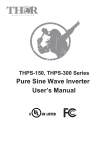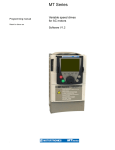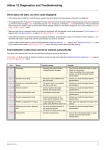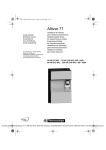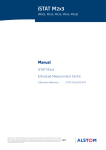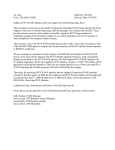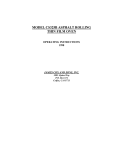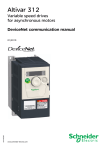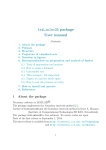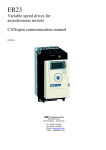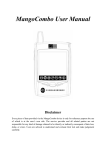Download Graphic display terminal
Transcript
Altivar 71 Stirrer application Programming manual Software V2.3IE40 Concast AAV75143 11/2009 www.schneider-electric.com Contents Before you begin______________________________________________________________________________________________ 4 Documentation structure________________________________________________________________________________________ 5 Steps for setting up the drive ____________________________________________________________________________________ 6 Setup - Preliminary recommendations _____________________________________________________________________________ 7 Graphic display terminal ________________________________________________________________________________________ 9 Description of terminal ___________________________________________________________________________________ 9 Description of the graphic screen __________________________________________________________________________ 10 First power-up - [5. LANGUAGE] menu _____________________________________________________________________ 13 Subsequent power ups __________________________________________________________________________________ 14 Structure of parameter tables ___________________________________________________________________________________ 17 [1.4 INPUTS / OUTPUTS CFG] (I_O-) ____________________________________________________________________________ 18 [1.14 CONCAST] (COn-) ______________________________________________________________________________________ 19 Communication______________________________________________________________________________________________ 28 Maintenance ________________________________________________________________________________________________ 30 Faults - Causes - Remedies ____________________________________________________________________________________ 31 User settings tables __________________________________________________________________________________________ 37 Index of parameter codes ______________________________________________________________________________________ 38 AAV75143 11/2009 3 Before you begin Read and understand these instructions before performing any procedure on this drive. DANGER HAZARDOUS VOLTAGE • Read and understand the Installation Manual before installing or operating the ATV71 drive. Installation, adjustment, repair, and maintenance must be performed by qualified personnel. • The user is responsible for compliance with all international and national electrical standards in force concerning protective grounding of all equipment. • Many parts of this variable speed drive, including the printed circuit boards, operate at the line voltage. DO NOT TOUCH. Use only electrically insulated tools. • DO NOT touch unshielded components or terminal strip screw connections with voltage present. • DO NOT short across terminals PA/+ and PC/- or across the DC bus capacitors. • Install and close all the covers before applying power or starting and stopping the drive. • Before servicing the variable speed drive - Disconnect all power. - Place a “DO NOT TURN ON” label on the variable speed drive disconnect. - Lock the disconnect in the open position. • Disconnect all power including external control power that may be present before servicing the drive. WAIT 15 MINUTES to allow the DC bus capacitors to discharge. Then follow the DC bus voltage measurement procedure given in the Installation Manual to verify that the DC voltage is less than 42 V. The drive LEDs are not accurate indicators of the absence of DC bus voltage. Failure to follow these instructions will result in death or serious injury. CAUTION DAMAGED EQUIPMENT Do not operate or install any drive that appears damaged. Failure to follow this instruction can result in injury or equipment damage. 4 AAV75143 11/2009 Documentation structure This manual describes only specific parameters and [CONCAST] (COn-) menu . For other functions, refer to the following Altivar 71 technical documents. They are available on the Schneider Electric website (www.schneider-electric.com) as well as on the CD-ROM supplied with the drive. Installation Manual This describes how to assemble and connect the drive. Programming manual This describes the functions, parameters and use of the drive terminal (integrated display terminal and graphic display terminal). The communication functions are not described in this manual, but in the manual for the bus or network used. Communication Parameters Manual This manual describes: • The drive parameters with specific information for use via a bus or communication network. • The operating modes specific to communication (state chart). • The interaction between communication and local control. Manuals for Modbus, CANopen, Ethernet, Profibus, INTERBUS, Uni-Telway, FIPIO and Modbus Plus, etc. These manuals describe the assembly, connection to the bus or network, signaling, diagnostics, and configuration of the communicationspecific parameters via the integrated display terminal or the graphic display terminal. They also describe the communication services of the protocols. AAV75143 11/2009 5 Steps for setting up the drive INSTALLATION v 1 Consult the Installation Manual PROGRAMMING b 2 Power up without run command v If you are using a separate power supply for the control section, follow the instructions on page 7. b 3 Select the language, if the drive has a graphic display terminal b 4 Configure the [CONCAST] Tips: • Before you start programming, complete the user setting tables, page 37. (COn-) menu b 5 Start • Perform an auto-tuning operation to optimize performance. • If you get lost, return to the factory settings. Note: Check that the wiring of the drive is compatible with its configuration. 6 AAV75143 11/2009 Setup - Preliminary recommendations Turning on and configuring the drive DANGER UNINTENDED EQUIPMENT OPERATION • Before turning on and configuring the Altivar 71, check that the PWR (POWER REMOVAL) input is deactivated (at state 0) in order to prevent unintended operation. • Before turning on the drive, or when exiting the configuration menus, check that the inputs assigned to the run command are deactivated (at state 0) since they can cause the coil to start immediately. Failure to follow these instructions will result in death or serious injury. CAUTION INCOMPATIBLE LINE VOLTAGE Before turning on and configuring the drive, ensure that the line voltage is compatible with the supply voltage range shown on the drive nameplate. The drive may be damaged if the line voltage is not compatible. Failure to follow this instruction can result in equipment damage. Separate control section power supply When the drive control section is powered independently of the power section (P24 and 0V terminals), whenever an option card is added or replaced, only the power section must be supplied with power next time the drive is powered up. By default the new card would not be recognized and it would be impossible to configure it, thereby causing the drive to lock in fault mode. Power switching via line contactor CAUTION UNINTENDED EQUIPMENT OPERATION • Avoid operating the contactor frequently (premature ageing of the filter capacitors). • Cycle times < 60 s may result in damage to the pre-charge resistor. Failure to follow these instructions can result in equipment damage. AAV75143 11/2009 7 Setup - Preliminary recommendations User adjustment and extension of functions • The display unit and buttons can be used to modify the settings and to extend the functions described in the following pages. • Return to factory settings is made easy by the [1.11 FACTORY SETTINGS] (FCS-) menu. • There are three types of parameter: - Display: Values displayed by the drive - Adjustment: Can be changed during operation or when stopped - Configuration: Can only be modified when stopped and no braking is taking place. Can be displayed during operation. DANGER UNINTENDED EQUIPMENT OPERATION • Check that changes made to the settings during operation do not present any danger. • We recommend stopping the drive before making any changes. Failure to follow these instructions will result in death or serious injury. Starting Important: • In factory settings mode, the coil can only be supplied with power once the “forward”, “reverse” and “DC injection stop” commands have been reset: - On power-up or a manual fault reset or after a stop command If they have not been reset, the drive will display "nSt" but will not start. • If the automatic restart function has been configured ([Automatic restart] (Atr) parameter in the [1.7 FAULT MANAGEMENT] (FLt-) menu), these commands are taken into account without a reset being necessary. Compatibility of functions Important: This software version is specific. The compatibility between "common" functions of the drive and [1.14 CONCAST] (COn-) menu has not been tested. The user must therefore ensure that these functions can be used at the same time. 8 AAV75143 11/2009 Graphic display terminal The graphic display terminal is a standard component on high-power drives. The graphic display terminal can be disconnected and connected remotely (on the door of an enclosure for example) using the cables and accessories available as options (see catalog). Description of terminal 1 Graphic display 2 Function keys F1, F2, F3, F4, see page 10. 7 ESC key: Aborts a value, a parameter or a menu to return to the previous selection 3 STOP/RESET button 6 Button for reversing the direction of rotation of the coil 4 RUN button 5 Navigation button: • Press (ENT): - To save the current value - To enter the selected menu or parameter • Turn CW/ CCW: - To increment or decrement a value - To go to the next or previous line - To increase or decrease the reference if control via the terminal is activated Note: Buttons 3, 4, 5 and 6 can be used to control the drive directly, if control via the terminal is activated. Disconnected terminal When the terminal is disconnected, 2 LEDs become visible: Green LED: DC bus ON Red LED: Fault HMI Modbus AAV75143 11/2009 9 Graphic display terminal Description of the graphic screen 1 RDY 2 Term +0.00 Hz 0A 6 1 DRIVE MENU 1.1 SIMPLY START 1.2 MONITORING 1.3 SETTINGS 3 1.4 INPUTS / OUTPUTS CFG 1.5 COMMAND 4 Code << >> Quick F1 F2 F3 F4 5 1. Display line. Its content can be configured; the factory settings show: • The drive state • The active control channel: - Term: Terminals - HMI: Graphic display terminal - MDB: Integrated Modbus - CAN: Integrated CANopen - NET: Communication card - APP: Controller Inside card • Frequency reference • Current in the coil 2. Menu line. Indicates the name of the current menu or submenu. 3. Menus, submenus, parameters, values, bar charts, etc., are displayed in drop-down window format on a maximum of 5 lines. The line or value selected by the navigation button is displayed in reverse video. 4. Section displaying the functions assigned to the F1 to F4 keys and aligned with them, for example: • Code F1 : Displays the code of the selected parameter, i.e., the code corresponding to the 7-segment display. • HELP F1 : Contextual help • << F2 : Navigate horizontally to the left, or go to previous menu/submenu or, for a value, go to the next digit up, displayed in reverse video. • >> F3 : Navigate horizontally to the right or go to next menu/submenu (going to the [2 ACCESS LEVEL] menu in this example) or, for a value, go to the next digit down, displayed in reverse video. • Quick F4 : Quick navigation. The function keys are dynamic and contextual. Other functions (application functions) can be assigned to these keys via the [1.5 COMMAND] menu. 5. Indicates that there are no more levels below this display window. Indicates that there are more levels below this display window. 6. Indicates that this display window does not scroll further up. Indicates that there are more levels above this display window. 10 AAV75143 11/2009 Graphic display terminal Drive state codes: - ACC: Acceleration CLI: Current limit CTL: Controlled stop on input phase loss DCB: DC injection braking in progress DEC: Deceleration FLU: Coil fluxing in progress FST: Fast stop NLP: No line power (no line supply on L1, L2, L3) NST: Freewheel stop OBR: Auto-adapted deceleration PRA: Power Removal function active (drive locked) RDY: Drive ready RUN: Drive running SOC: Controlled output cut in progress TUN: Auto-tuning in progress USA: Undervoltage alarm AAV75143 11/2009 11 Graphic display terminal Example configuration windows: RDY Term +0.00Hz 5 LANGUAGE 0A When only one selection is possible, the selection made is indicated by Example: Only one language can be chosen. English Français Deutsch Español Italiano << >> Quick Chinese PARAMETER SELECTION 1.3 SETTINGS Ramp increment Acceleration Deceleration Acceleration 2 Deceleration 2 Edit When multiple selection is possible, the selections made are indicated by Example: A number of parameters can be chosen to form the [1.12 USER MENU] (UMC-). Example configuration window for one value: RDY Term Acceleration +0.00Hz 0A << >> +0.00Hz 0A >> 9.51 s Min = 0.01 RDY Term Acceleration 951 s Max = 99.99 Quick Min = 0.01 << >> Max = 99.99 Quick The << and >> arrows (keys F2 and F3) are used to select the digit to be modified, and the navigation button is rotated to increase or decrease this number. 12 AAV75143 11/2009 Graphic display terminal First power-up - [5. LANGUAGE] menu The first time the drive is powered up, the user will automatically be guided through the menus as far as [1. DRIVE MENU]. The parameters in the [1.1 SIMPLY START] submenu must be configured and auto-tuning performed before the coil is started up. Display for 3 seconds following power-up ATV71HC20N4 200kW/300HP 380/480V Config. n°1 3 seconds 5 LANGUAGE English Français Deutsch Español Italiano Automatically switches to [5 LANGUAGE] menu 3 seconds later. Select the language and press ENT. Chinese RDY Term +0.00Hz 2 ACCESS LEVEL 0.0A Switches to [2 ACCESS LEVEL] menu Basic Standard Advanced Expert Select the access level and press ENT. RDY Term +0.00Hz 0.0A 1 DRIVE MENU 1.1 SIMPLY START 1.2 MONITORING 1.3 SETTINGS 1.4 INPUTS / OUTPUTS CFG 1.5 COMMAND Code << >> Quick Switches to [1 DRIVE MENU] ESC RDY Term +0.00Hz MAIN MENU 1 DRIVE MENU 2 ACCESS LEVEL 3 OPEN / SAVE AS 4 PASSWORD 5 LANGUAGE Code AAV75143 11/2009 0.0A Press ESC to return to [MAIN MENU] Quick 13 Graphic display terminal Subsequent power ups ATV71HC20N4 200kW/300HP 380/480V Config. n°1 3 seconds RDY Term +38Hz 0.0A 1. DRIVE MENU 1.1 SIMPLY START 1.2 MONITORING 1.3 SETTINGS 1.4 INPUTS / OUTPUTS CFG 1.5 COMMAND Code << >> Quick Switches to [1. DRIVE MENU] 3 seconds later. 10 seconds RDY Term +38Hz Frequency ref. 0.0A If no operator inputs are made, switches to "Display" automatically 10 seconds later (the display will vary depending on the selected configuration). 38 Hz Min=0 Max=60 Quick ENT or ESC RDY Term +38Hz MAIN MENU 1 DRIVE MENU 2 ACCESS LEVEL 3 OPEN / SAVE AS 4 PASSWORD 5 LANGUAGE Code 14 0.0A Users can return to [MAIN MENU] by pressing ENT or ESC. Quick AAV75143 11/2009 Graphic display terminal [MAIN MENU] - Menu mapping RDY Term +0.00Hz MAIN MENU 1 DRIVE MENU 2 ACCESS LEVEL 3 OPEN / SAVE AS 4 PASSWORD 5 LANGUAGE Code 6 MONITORING CONFIG. 7 DISPLAY CONFIG. 0A RDY Term +0.00Hz 0A 1 DRIVE MENU 1.1 SIMPLY START 1.2 MONITORING 1.3 SETTINGS 1.4 INPUTS / OUTPUTS CFG 1.5 COMMAND Code << >> Quick 1.6 APPLICATION FUNCT. 1.7 FAULT MANAGEMENT 1.8 COMMUNICATION 1.9 DIAGNOSTICS 1.11 FACTORY SETTINGS 1.12 USER MENU 1.13 PROGRAMMABLE CARD 1.14 CONCAST Quick Content of [MAIN MENU] menus [1 DRIVE MENU] See next page [2 ACCESS LEVEL] Defines which menus can be accessed (level of complexity) [3 OPEN / SAVE AS] Can be used to save and recover drive configuration files [4 PASSWORD] Provides password protection for the configuration [5 LANGUAGE] Language selection [6 MONITORING CONFIG.] Customization of information displayed on the graphic display terminal during operation [7 DISPLAY CONFIG.] AAV75143 11/2009 • Customization of parameters • Creation of a customized user menu • Customization of the visibility and protection mechanisms for menus and parameters 15 Graphic display terminal [1 DRIVE MENU] RDY Term +0.00Hz 0A 1 DRIVE MENU 1.1 SIMPLY START 1.2 MONITORING 1.3 SETTINGS 1.4 INPUTS / OUTPUTS CFG 1.5 COMMAND Code << >> Quick 1.6 APPLICATION FUNCT. 1.7 FAULT MANAGEMENT 1.8 COMMUNICATION 1.9 DIAGNOSTICS 1.11 FACTORY SETTINGS 1.12 USER MENU 1.13 PROGRAMMABLE CARD 1.14 CONCAST Content of [1. DRIVE MENU] menus: [1.1 SIMPLY START]: Simplified menu for a quick start [1.2 MONITORING]: Visualization of current, coil and input/output values [1.3 SETTINGS]: Accesses the adjustment parameters, which can be modified during operation [1.4 INPUTS / OUTPUTS CFG]: I/O configuration (scaling, filtering, 2-wire control, 3-wire control, etc.) [1.5 COMMAND]: Configuration of command and reference channels (graphic display terminal, terminals, bus, etc.) [1.6 APPLICATION FUNCT.]: Configuration of application functions (e.g., preset speeds, PID, brake logic control, etc.) [1.7 FAULT MANAGEMENT] : Configuration of fault management [1.8 COMMUNICATION]: Communication parameters (fieldbus) [1.9 DIAGNOSTICS]: Coil/drive diagnostics [1.11 FACTORY SETTINGS]: Access to configuration files and return to factory settings [1.12 USER MENU]: Specific menu set up by the user in the [7. DISPLAY CONFIG.] menu [1.13 PROGRAMMABLE CARD]: Configuration of optional Controller Inside card [1.14 CONCAST]: Specific menu for Concast 16 AAV75143 11/2009 Structure of parameter tables The parameter tables in the descriptions of the various menus can be used with both the graphic display terminal and the integrated display terminal. They, therefore, contain information for these two terminals in accordance with the description below. Example: 5 [1.6 APPLICATION FUNCT.] (FUn-) 6 1 Code 2 Name/Description b UPd- Adjustment range Factory setting [+/- SPEED] Function can be accessed for reference channel [Ref.2 channel] (Fr2) = [+/- speed] (UPdt) , 3 USP no LI1 4 M [+ speed assignment] v [No] (nO): function inactive v [LI1] (LI1) 7 [No] (nO) 8 1. Name of menu on 4-digit 7-segment display. 5. Name of menu on graphic display terminal. 2. Submenu code on 4-digit 7-segment display. 6. Name of submenu on graphic display terminal. 3. Parameter code on 4-digit 7-segment display. 7. Name of parameter on graphic display terminal. 4. Parameter value on 4-digit 7-segment display. 8. Value of parameter on graphic display terminal. Note : • The text in square brackets [ ] indicates what you will see on the graphic display terminal. • The factory settings correspond to [Macro configuration] (CFG) = [Start/Stop] (StS). This is the macro configuration set at the factory. AAV75143 11/2009 17 [1.4 INPUTS / OUTPUTS CFG] (I_O-) RDY RDY Term +0.00Hz MAIN MENU 1 DRIVE MENU 2 ACCESS LEVEL 3 OPEN / SAVE AS 4 PASSWORD 5 LANGUAGE Code Code 0A ENT Term +0.00Hz 0A 1 DRIVE MENU 1.1 SIMPLY START 1.2 MONITORING 1.3 SETTINGS 1.4 INPUTS / OUTPUTS CFG 1.5 COMMAND Code << >> Quick Quick Name/Description M [Min. current] W18 T Minimum current. W19 M [Max. current] T Maximum current. W24 M [Trig level fast stop] LO HIG T T RUN ENT v v Term +50.00Hz 80A 1.4 INPUTS / OUTPUS CFG 2/3 wire control 2 wire type Reverse assign. LI1 CONFIGURATION LI2 CONFIGURATION Code << >> Quick Adjustment range Factory setting 0.0 to 1500.0 A 0.0 A 0.0 to 1500.0 A According to the range (1) - [LO] (LO) Level fast stop activation [LO] (LO) [HIG] (HIG) Parameter that can be modified during operation or when stopped. (1) This table shows the factory setting for the parameter [Max. current] (W19) according to the drive rating. Drive reference W19 Factory setting (A) ATV71HC20N4, ATV71HC22N4 522 ATV71HC25N4 600 ATV71HC28N4 682 ATV71HC31N4, ATV71HC35N4 821 ATV71HC40N4, ATV71HC45N4 1026 ATV71HC50N4 1321 18 AAV75143 11/2009 [1.14 CONCAST] (COn-) RDY RDY Term +0.00Hz MAIN MENU 1 DRIVE MENU 2 ACCESS LEVEL 3 OPEN / SAVE AS 4 PASSWORD 5 LANGUAGE Code AAV75143 11/2009 0A ENT Term +0.00Hz 0A 1 DRIVE MENU 1.11 FACTORY SETTINGS 1.12 USER MENU 1.13 PROGRAMMABLE CARD 1.14 CONCAST Code Quick << >> Quick RUN ENT Term +50.00Hz 80A 1.14 CONCAST Frequency ref. Current reference Freq. after ramp Current after ramp Coil current Code << >> Quick 19 [1.14 CONCAST] (COn-) The parameters in the [1.14 CONCAST] (drC-) menu can only be modified when the drive is stopped and no run command is present, with the following exception: • Parameters containing the sign Tin the code column can be modified with the drive running or stopped. • Parameters containing the sign Oin the code column are only in read access. Code Unit FrH O [Frequency ref.]: Frequency reference before ramp (signed value). 0,1 Hz LtrA O [Current reference]: Active Ligne current reference Ltr (signed value). 0,1 A FrO O [Freq. after ramp]: Ramp output frequency (signed value). 0,1 Hz W02 O [Current after ramp]: Current in the coil. 0,1 A LCr O [Coil current]: Estimated coil current. 0,1 A ULn O [Mains voltage]: Main voltage (from DC bus). 0,1 V W03 O [Coil voltage]: Voltage in the coil. 0,1 V W04 O [Coil active power]: Coil active power. 0,1 kW W05 O [Coil reactive power]: Output reactive power. 0,1 kVA W06 O [Coil power factor]: Output power factor. 0,01 pf W07 O [Coil voltage Vd axis]: Output voltage reference Vd. 0,1 V W08 O [Coil voltage Vq axis]: Output voltage reference Vq. 0,1 V O 20 Name/Description Parameter only in read access. AAV75143 11/2009 [1.14 CONCAST] (COn-) PFL- [CURRENT FAULT LIST] RDY RDY Term +0.00Hz MAIN MENU 1 DRIVE MENU 2 ACCESS LEVEL 3 OPEN / SAVE AS 4 PASSWORD 5 LANGUAGE Code 0A ENT RUN ENT Term +50.00Hz 80A 1.14 CONCAST Coil voltage Vd axis Coil voltage Vq axis CURRENT FAULT LIST ETA state word Freq Accel Ramp Code << >> Quick Quick RUN Term +50.00Hz 80A CURRENT FAULT LIST internal com. link ----------------Code Quick AAV75143 11/2009 Term +0.00Hz 0A 1 DRIVE MENU 1.1 SIMPLY START 1.2 MONITORING 1.3 SETTINGS 1.4 INPUTS / OUTPUTS CFG 1.5 COMMAND Code << >> Quick 1.6 APPLICATION FUNCT. 1.7 FAULT MANAGEMENT 1.8 COMMUNICATION 1.9 DIAGNOSTICS 1.11 FACTORY SETTINGS 1.12 USER MENU 1.13 PROGRAMMABLE CARD 1.14 CONCAST RUN ENT Term +50.00Hz internal com. link Drive state ETA status word ETI status word Cmd word Motor current HELP Output frequency Elapsed time Line voltage Motor thermal state Command Channel Channel ref. active 80A RDY ... ... ... ... Quick ... ... ... ... ... ... This screen indicates the state of the drive at the moment the selected fault occurred. 21 [1.14 CONCAST] (COn-) Code EtA O Name/Description M [ETA state word] Possible values in the IO profile Note: The value is identical in the CiA402 profile and the I/O profile. In the I/O profile, the description of the values is simplified and does not refer to the CiA402 (Drivecom) state chart. bit 0:Reserved (= 0 or 1) bit 1:Ready = 0: Not ready, = 1: Ready bit 2:Running = 0: The drive will not start if a reference other than zero is applied. = 1: Running, if a reference other than zero is applied, the drive can start. bit 3:Fault = 0: No fault, = 1: Fault bit 4:Power section line supply present = 0: Power section line supply absent, = 1: Power section line supply present bit 5:Reserved (= 1) bit 6:Reserved (= 0 or 1) bit 7:Alarm = 0: No alarm, = 1: Alarm bit 8:Reserved (= 0) bit 9:Command via a network = 0: Command via the terminals or the graphic display terminal, = 1: Command via a network Note: The network can be integrated Modbus, CANopen, a communication card or the Controller Inside card. This is not necessarily the network via which the status word is read. Therefore, if the command comes from CANopen (CANopen command channel active) and the status word (ETA) is read via an Ethernet card, the data item "Control via a network" = 1. This does not mean that control can be carried out via the Ethernet card. bit 10:Reference reached = 0: The reference is not reached, = 1: The reference has been reached bit 11:Reference outside limits = 0: The reference is within the limits, = 1: The reference is not within the limits When the drive is in speed mode, the limits are defined by the "Low speed (LSP)" and "High speed (HSP)" parameters. bits 12 and 13: Reserved (= 0) bit 14:Stop via STOP key = 0: STOP key not pressed, = 1: Stop triggered by the STOP key on the graphic display terminal bit 15:Direction of rotation = 0: Forward rotation at output, = 1: Reverse rotation at output O 22 Parameter only in read access. AAV75143 11/2009 [1.14 CONCAST] (COn-) Code Name/Description Possible values in CiA402 profile bit 0:"Ready to switch on", awaiting power section line supply bit 1:"Switched on", ready bit 2:"Operation enabled", running bit 3:"Fault" = 0: No fault, = 1: Fault bit 4:"Voltage enabled", power section line supply present = 0: Power section line supply absent, = 1: Power section line supply present When the drive is powered by the power section only, this bit is always at 1. bit 5:Quick stop/Emergency stop bit 6:"Switched on disabled", power section line supply locked bit 7:Warning alarm = 0: No alarm, = 1: Alarm bit 8:Reserved (= 0) bit 9:Remote: command or reference via the network = 0: Command or reference via the terminals, = 1: Command or reference via the network bit 10:Target reference reached = 0: The reference is not reached, = 1: The reference has been reached When the drive is in speed mode, this is the speed reference. When the drive stops, the reference has been reached. bit 11:"Internal limit active", reference outside limits = 0: The reference is within the limits, = 1: The reference is not within the limits When the drive is in speed mode, the limits are defined by the "Low speed (LSP)" and "High speed (HSP)" parameters. bit 12:Reserved (= 0) bit 13:Reserved (= 0) bit 14:"Stop key", STOP via stop key = 0: STOP key not pressed, = 1: Stop triggered by the STOP key on the graphic display terminal bit 15:"Direction", direction of rotation = 0: Forward rotation at output, = 1: Reverse rotation at output AAV75143 11/2009 23 [1.14 CONCAST] (COn-) Code Name/Description M [Freq Accel Ramp] ACC Adjustment range Factory setting 0.01 to 6000 s (1) 5.0 s Time to accelerate from 0 to the [Rated motor freq.] (FrS). Make sure that this value is compatible with the inertia being driven. T M [Freq Decel Ramp] dEC 0.01 to 6000 s (1) 5.0 s Time to decelerate from the [Rated motor freq.] (FrS) to 0. Make sure that this value is compatible with the inertia being driven. T W09 M [Current Accel Ramp] T Current acceleration W10 M [Current Decel Ramp] T Current deceleration M [ASM Mode] W11 nO YES v v 5.0 s 0.1 to 50.0 s 5.0 s - [No] (nO) 1 to 900 s 5s 1 to 900 s 5s Alternating stirring control [No] (nO) [Yes] (YES) W12 M [Cw time ASM Mode] T ASM clockwise time W13 M [C/Ctime ASM Mode] T 0.1 to 50.0 s ASM anti-clockwise time OPL nO YES OAC [Yes] (YES) M [Output Phase Loss] v [No] (nO): Function inactive v [Yes] (YES): Tripping on OPF fault with freewheel stop. v [Output cut] (OAC): No fault triggered, but management of the output voltage in order to avoid an overcurrent when the link with the coil is re-established and catch on the fly performed (even if this function has not been configured). Note: [Output Phase Loss] (OPL) is forced to [Yes] (YES) if brake logic control is configured (see ATV71 programming manual). W01 M [OutPhL Voltage] 50 to 500 V 200 V 1 to 100 ms 10 ms 0 to 100 % 100 % Open circuit coil trip level. Odt T W20 T M [OutPhL Time] Output (coil) phase loss detection time M [OutputV in % InputV] Field weakening (1) Range 0.01 to 99.99 s or 0.1 to 999.9 s or 1 to 6000 s according to [Ramp increment] (Inr). T 24 Parameter that can be modified during operation or when stopped. AAV75143 11/2009 [1.14 CONCAST] (COn-) Command and reference channels The parameters in [Cmd channel] (Cd1) and [Freq. ref. channel] (Fr1) can only be modified when the drive is stopped and no run command is present. Run commands (forward, reverse, stop, etc.) and references can be sent using the following channels: Control • • • • • • Reference Terminals: logic inputs LI Graphic display terminal Integrated Modbus Integrated CANopen Communication card Controller Inside card • • • • • • • • Terminals: analog inputs AI, frequency input, encoder Graphic display terminal Integrated Modbus Integrated CANopen Communication card Controller Inside card +/- speed via the terminals +/- speed via the graphic display terminal The behavior of the Altivar 71 can be adapted according to requirements: • [Not separ.] (SIM): Command and reference are sent via the same channel. • [Separate] (SEP): Command and reference may be sent via different channels. In these configurations, control via the communication bus is performed in accordance with the DRIVECOM standard with only 5 freelyassignable bits (see Communication Parameters Manual). The application functions cannot be accessed via the communication interface. • [I/O profile] (IO): The command and the reference can come from different channels. This configuration both simplifies and extends use via the communication interface. Commands may be sent via the logic inputs on the terminals or via the communication bus. When commands are sent via a bus, they are available on a word, which acts as virtual terminals containing only logic inputs. Application functions can be assigned to the bits in this word. More than one function can be assigned to the same bit. Note: Stop commands from the terminals remain active even if the terminals are not the active command channel. Note : The integrated Modbus channel has 2 physical communication ports: - The Modbus network port - The Modbus HMI port The drive does not differentiate between these two ports, but recognizes the graphic display terminal irrespective of the port to which it is connected. Code Cd1 tEr LCC Mdb CAn nEt APP Name/Description M [Cmd channel] v [Terminals] (tEr): Terminals v [HMI] (LCC): Graphic display terminal v [Modbus] (Mdb): Integrated Modbus v [CANopen] (CAn): Integrated CANopen v [Com. card] (nEt): Communication card (if inserted) v [C.Insid. card] (APP): Controller Inside card (if inserted) Factory setting [Terminals] (tEr) The parameter is available if [Profile] (CHCF) = [Separate] (SEP) or [I/O profile] (IO). Fr1 AI1 AI2 AI3 AI4 LCC Mdb CAn nEt APP PI PG AAV75143 11/2009 M [Freq. ref. channel] v [AI1] (AI1): Analog input v [AI2] (AI2): Analog input v [AI3] (AI3): Analog input, if VW3A3202 extension card has been inserted v [AI4] (AI4): Analog input, if VW3A3202 extension card has been inserted v [HMI] (LCC): Graphic display terminal v [Modbus] (Mdb): Integrated Modbus v [CANopen] (CAn): Integrated CANopen v [Com. card] (nEt): Communication card (if inserted) v [C.Insid. card] (APP): Controller Inside card (if inserted) v [RP] (PI): Frequency input, if VW3A3202 extension card has been inserted, v [Encoder] (PG): Encoder input, if encoder card has been inserted [AI2] (AI2) 25 [1.14 CONCAST] (COn-) Code Name/Description tr1 nO AI1 AI2 AI3 AI4 LCC Mdb CAn nEt APP PI PG Adjustment range M [Current ref. channel] v [No] (nO): Not assigned (zero torque reference). v [AI1] (AI1): Analog input v [AI2] (AI2): Analog input v [AI3] (AI3): Analog input, if VW3A3202 I/O card has been inserted v [AI4] (AI4): Analog input, if VW3A3202 I/O card has been inserted v [HMI] (LCC): Graphic display terminal v [Modbus] (Mdb): Integrated Modbus v [CANopen] (CAn): Integrated CANopen v [Com. card] (nEt): Communication card (if inserted) v [C.Insid. card] (APP): Controller Inside card (if inserted) v [RP] (PI): Frequency input, if VW3A3202 I/O card has been inserted v [Encoder] (PG): Encoder input, if encoder card has been inserted Factory setting [AI2] (AI2) (1) 100% of the reference corresponds to 300% of the rated torque. W14 M [Coil nom. voltage] 200 to 480 V 415 V 0.1 to 1500.0 A According to drive rating 0.1 to 50 Hz 5 Hz 0.01 to 0.99 pf 0.30 pf 0.0 to 1600.0 Hz 0 Hz Coil nominal voltage. W15 M [Coil nom. current] Coil nominal current. W16 M [Coil nom. frequency] Coil nominal frequency. W17 M [Coil nom. Powerfact] Coil nominal powerfactor. LSP T HSP T W18 M [Min frequency] Coil frequency at minimum reference, can be set between 0 and [High speed] (HSP). M [Max frequency] M [Min. current] Minimum current. W19 M [Max. current] T Maximum current. LFr M [HMI Frequency ref.] Ltr T 5.0 Hz Coil frequency at maximum reference, can be set between [Low speed] (LSP) and [Max frequency] (tFr). The factory setting changes to 60 Hz if [Standard mot. freq] (bFr) = [60Hz NEMA] (60). T T 0.0 to 100 Hz 0.0 to 1500.0 A 0.0 A 0.0 to 1500.0 A According to the range (2) -3276.7 to 3276.7 Hz 0 Hz 0.0 to 1500.0 A 0.0 A Frequency reference via the graphic display terminal. M [HMI current ref.] Current reference via the graphic display terminal. (1) If VW3A3202 extension card has been inserted, the factory setting is [AI4] (AI4). (2) See table with factory setting for W19 page 18. T 26 Parameter that can be modified during operation or when stopped. AAV75143 11/2009 [1.14 CONCAST] (COn-) Code Name/Description PHr AbC ACb M [Output Ph rotation] v [ABC] (AbC): Forward v [ACB] (ACb): Reverse Adjustment range Factory setting - [ABC] (AbC) This parameter can be used to reverse the frequency direction of coil rotation without reversing the wiring. M [BW Current loop] W21 T 10 Hz 0 to 1000 % 100 % 0 to 100 % 15 % - [No] (nO) - [Yes] (YES) Current loop Bandwidth. M [Damp Current loop] W22 T Current loop Damping. M [Phase Comp. coeff.] W23 T Field weakening. W25 nO YES T M [Freq. ramp reverse] v [No] (nO) v [Yes] (YES) With or without ramp during reverse action. W26 nO YES T T 0 to 1000 Hz M [Freq ramp startstop] v [No] (nO) v [Yes] (YES) With or without ramp for start and stop. Parameter that can be modified during operation or when stopped. AAV75143 11/2009 27 Communication Code Low limit High limit Default value Logic address CANopen index ACC 1 6000 50 9001 16#203C/2 Cd1 1 = (tEr): Terminals 3 = (LCC): Graphic display terminal 10 = (Mdb): Integrated Modbus 20 = (CAn): Integrated CANopen 30 = (nEt): Communication card (if inserted) 31 = (APP): Controller Inside card (if inserted) 1 8423 16#2036/18 dEC 1 50 9002 16#203C/3 EtA see page 22 - 3201 16#2002/2 Fr1 1 = (AI1): Analog input 2 = (AI2): Analog input 3 = (AI3): Analog input, if VW3A3202 extension card has been inserted 4 = (AI4): Analog input, if VW3A3202 extension card has been inserted 163 = (LCC): Graphic display terminal 164 = (Mdb): Integrated Modbus 167 = (CAn): Integrated CANopen 169 = (nEt): Communication card (if inserted) 170 = (APP): Controller Inside card (if inserted) 181 = (PI): Frequency input, if VW3A3202 extension card has been inserted 182 = (PG): Encoder input, if encoder card has been inserted 2 8413 16#2036/E -16000 +16000 - 3203 16#2002/4 FrH 6000 FrO - - 9021 16#203C/16 HSP 0 1000 50 3104 16#2001/5 LCr 0 65535 - 3204 16#2002/5 LFr -32767 +32767 0 8502 16#2037/3 Ltr 0 15000 0 8505 16#2037/6 LtrA 0 15000 - 8559 16#2037/3C LSP 0 16000 0 3105 16#2001/6 Odt 1 100 10 7081 16#2028/52 OPL 0 = (nO): Function inactive 1 = (YES): Tripping on OPF fault with freewheel stop. 2 = (OAC): No fault triggered 1 9611 16#2042/C PHr 0 = (AbC): Forward 1 = (ACb): Reverse 0 13401 16#2068/2 tr1 0 = (nO): Not assigned (zero torque reference). 1 = (AI1): Analog input 2 = (AI2): Analog input 3 = (AI3): Analog input, if VW3A3202 I/O card has been inserted 4 = (AI4): Analog input, if VW3A3202 I/O card has been inserted 163 = (LCC): Graphic display terminal 164 = (Mdb): Integrated Modbus 167 = (CAn): Integrated CANopen 169 = (nEt): Communication card (if inserted) 170 = (APP): Controller Inside card (if inserted) 181 = (PI): Frequency input, if VW3A3202 I/O card has been inserted 182 = (PG): Encoder input, if encoder card has been inserted 2 9221 16#203E/16 ULn 0 65535 - 3207 16#2002/8 W01 50 500 200 20501 16#20AF/2 W02 - - - 20502 16#20AF/3 W03 - - - 20503 16#20AF/4 W04 - - - 20504 16#20AF/5 W05 - - - 20505 16#20AF/6 W06 - - - 20506 16#20AF/7 28 AAV75143 11/2009 Communication Code Low limit High limit Default value Logic address CANopen index W07 - - - 20507 16#20AF/8 W08 - - - 20508 16#20AF/9 W09 1 500 50 20509 16#20AF/A W10 1 500 50 20510 16#20AF/B W11 0 = (nO) 1 = (YES) 0 20511 16#20AF/C W12 1 900 5 20512 16#20AF/D W13 1 900 5 20513 16#20AF/E W14 200 480 415 20514 16#20AF/F W15 1 15000 - 20515 16#20AF/10 W16 1 500 50 20516 16#20AF/11 W17 1 99 30 20517 16#20AF/12 W18 0 15000 0 20518 16#20AF/13 0 15000 According to the range (1) 20519 16#20AF/14 W20 0 100 100 20520 16#20AF/15 W21 0 1000 10 20521 16#20AF/16 W22 0 1000 100 20522 16#20AF/17 W23 0 100 15 20523 16#20AF/18 W24 0 = (LO) 1 = (HIG) 0 20524 16#20AF/19 W25 0 = (nO) 1 = (YES) 0 20525 16#20AF/1A W26 0 = (nO) 1 = (YES) 1 20526 16#20AF/1B W19 (1) See table with factory setting for W19 page 18. AAV75143 11/2009 29 Maintenance Servicing The Altivar 71 does not require any preventive maintenance. It is nevertheless advisable to perform the following regularly: • Check the condition and tightness of the connections. • Ensure that the temperature around the unit remains at an acceptable level and that ventilation is effective (average service life of fans: 3 to 5 years, depending on the operating conditions). • Remove any dust from the drive. Assistance with maintenance, fault display If a problem arises during setup or operation, first check that the recommendations relating to the environment, mounting and connections have been observed. The first fault detected is saved and displayed, and the drive locks. The drive switching to fault mode can be indicated remotely via a logic output or a relay, which can be configured in the [1.4 INPUTS / OUTPUTS CFG] (I-O-) menu, see, for example, [R1 CONFIGURATION] (r1-). Menu [1.9 DIAGNOSTICS] or menu [1.14 CONCAST] This menu displays faults and their cause in plain text and can be used to carry out tests. Clearing the fault Disconnect the drive power supply in the event of a non-resettable fault. Wait for the display to disappear completely. Find the cause of the fault in order to correct it. The drive is unlocked after a fault: • By switching off the drive until the display disappears completely, then switching on again • Automatically in the scenarios described for the[AUTOMATIC RESTART] (Atr-) function. • By means of a logic input or control bit assigned to the [FAULT RESET] (rSt-) function. • By pressing the STOP/RESET button on the graphic display terminal Menu [1.2 MONITORING] (SUP-): This is used to prevent and find the causes of faults by displaying the drive state and its current values. It can be accessed with the integrated display terminal. Spares and repairs: Consult Schneider Electric product support. 30 AAV75143 11/2009 Faults - Causes - Remedies Drive does not start, no fault displayed • If the display does not light up, check the power supply to the drive. • The assignment of the "Fast stop" or "Freewheel" functions will prevent the drive starting if the corresponding logic inputs are not powered up. The ATV71 then displays [Freewheel] (nSt) in freewheel stop and [Fast stop] (FSt) in fast stop. This is normal since these functions are active at zero so that the drive will be stopped safely if there is a wire break. • Make sure that the run command input or inputs are activated in accordance with the selected control mode ([2/3 wire control] (tCC) and [2 wire type] (tCt) parameters). • If an input is assigned to the limit switch function and this input is at zero, the drive can only be started up by sending a command for the opposite direction. • If the reference channel or command channel is assigned to a communication bus, when the power supply is connected, the drive will display [Freewheel] (nSt) and remain in stop mode until the communication bus sends a command. Faults, which cannot be reset automatically The cause of the fault must be removed before resetting by turning off and then back on. AnF, brF, ECF, EnF, SOF, SPF and tnF faults can also be reset remotely by means of a logic input or control bit ([Fault reset] (rSF) parameter). AnF, EnF, InFA, InFb, SOF, SPF, and tnF faults can be inhibited and cleared remotely by means of a logic input or control bit ([Fault inhibit assign.] (InH) parameter). Fault AI2F AnF Name Probable cause Remedy [AI2 input] • Non-conforming signal on analog input AI2 • Check the wiring of analog input AI2 and the value of the signal. [Load slipping] • The encoder speed feedback does not match • Check the coil, gain and stability parameters. the reference • Add a braking resistor. • Check the size of the coil/drive/load. • Check the encoder’s mechanical coupling and its wiring. bOF [DBR overload] • The braking resistor is under excessive stress brF [Brake feedback] • • bUF [DB unit sh. Circuit] • • CrF1 [Precharge] • CrF2 [Thyr. soft charge] • • Break in encoder’s mechanical coupling • Check the encoder’s mechanical coupling EEF1 [Control Eeprom] • Internal memory fault, control card EEF2 [Power Eeprom] • Internal memory fault, power card • Check the environment (electromagnetic compatibility) • Turn off, reset, return to factory settings • Inspect/repair the drive ECF [Encoder coupling] • Check the size of the resistor and wait for it to cool down • Check the [DB Resistor Power] (brP) and [DB Resistor value] (brU) parameters. The brake feedback contact does not match • Check the feedback circuit and the brake logic control circuit the brake logic control • Check the mechanical state of the brake The brake does not stop the coil quickly • Check the brake linings enough (detected by measuring the speed on the "Pulse input" input). Short-circuit output from braking unit • Check the wiring of the braking unit and the resistor. Braking unit not connected • Check the braking resistor • The monitoring of this fault must be disabled by the [Brake res. fault Mgt.] (bUb) parameter if there is no resistor or braking unit connected to the drive. Charging relay control fault or • Turn the drive off and then back on again charging resistor damaged • Check the internal connections • Inspect/repair the drive DC bus charging fault (thyristors) • Check [Number of pulses] (PGI) and [Encoder type] (EnS). • Check that the encoder’s mechanical and electrical operation, its power supply and connections are all correct • If necessary, reverse the direction of coil rotation ([Output Ph rotation] (PHr) parameter) or the encoder signals [Out. contact. stuck] • The output contactor remains closed • Check the contactor and its wiring FCF1 although the opening conditions have • Check the feedback circuit been met EnF [Encoder] AAV75143 11/2009 • Encoder feedback fault 31 Faults - Causes - Remedies Faults, which cannot be reset automatically (continued) Fault Name Probable cause Remedy HdF [IGBT desaturation] • Short-circuit or grounding at the drive output • Check the cables connecting the drive to the coil, and the coil insulation. • Perform the diagnostic tests via the [1.9 DIAGNOSTICS] menu. ILF [internal com. link] • Communication fault between option card and drive • Check the environment (electromagnetic compatibility) • Check the connections • Check that no more than 2 option cards (max. permitted) have been installed on the drive • Replace the option card • Inspect/repair the drive • Check the reference of the power card InF1 [Rating error] • The power card is different from the card stored InF2 [Incompatible PB] • The power card is incompatible with the control • Check the reference of the power card and its compatibility. card InF3 [Internal serial link] • Communication fault between the internal cards InF4 [Internal-mftg zone] • Internal data inconsistent InF6 [Internal - fault option] InF7 [Internal-hard init.] • The option installed in the drive is not recognized • Initialization of the drive is incomplete • Check the internal connections • Inspect/repair the drive • Recalibrate the drive (performed by Schneider Electric Product Support). • Check the reference and compatibility of the option. • Turn off and reset. InF8 [Internal-ctrl supply] • The control power supply is incorrect • Check the control section power supply InF9 [Internal- I measure] • The current measurements are incorrect • Replace the current sensors or the power card. • Inspect/repair the drive InFA [Internal-mains circuit] • The input stage is not operating correctly • Perform the diagnostic tests via the [1.9 DIAGNOSTICS] menu. • Inspect/repair the drive InFb [Internal- th. sensor] • The drive temperature sensor is not operating correctly • The braking unit's temperature sensor is not operating correctly. • • • • • InFC [Internal-time meas.] • Fault on the electronic time measurement component Replace the drive temperature sensor Inspect/repair the drive Replace the braking unit's temperature sensor Inspect/repair the braking unit The monitoring of this fault must be disabled by the [Brake res. fault Mgt.] (bUb) parameter if there is no braking unit connected to the drive. • Inspect/repair the drive [internal- CPU ] • Internal microprocessor fault OCF [Overcurrent] • Parameters in the [SETTINGS] (SEt-) • Check the parameters. and [1.4 MOTOR CONTROL] (drC-) • Check the size of the coil/drive/load. menus are not correct. • Check the state of the mechanism. • Inertia or load too high • Mechanical locking PrF [Power removal] • Fault with the drive’s "Power removal" safety function InFE • Turn off and reset. Inspect/repair the drive. • Inspect/repair the drive SCF1 [Motor short circuit] • Short-circuit or grounding at the drive • Check the cables connecting the drive to the coil, and the coil output insulation. SCF2 [Impedant sh. circuit] • Perform the diagnostic tests via the [1.9 DIAGNOSTICS] menu. SCF3 [Ground short circuit] • Significant earth leakage current at the drive • Reduce the switching frequency. output if several coils are connected in • Connect chokes in series with the coil. parallel SOF 32 [Overspeed] • Instability or driving load too high • • • • Check the coil, gain and stability parameters. Add a braking resistor. Check the size of the coil/drive/load. Check the parameters settings for the [FREQUENCY METER] (FqF-) function, if it is configured AAV75143 11/2009 Faults - Causes - Remedies Faults, which cannot be reset automatically (continued) Fault SPF Name Probable cause [Speed fdback loss] • Encoder feedback signal missing • Signal on "Pulse input" missing, if the input is used for speed measurement tnF [Auto-tuning] • Check the wiring between the encoder and the drive • Check the encoder • Check the wiring of the input cable and the detector used • Special coil or coil whose power is not suitable • Check that the coil/drive are compatible for the drive • Coil not connected to the drive AAV75143 11/2009 Remedy • Check that the coil is present during auto-tuning • If an output contactor is being used, close it during autotuning 33 Faults - Causes - Remedies Faults that can be reset with the automatic restart function, after the cause has disappeared These faults can also be reset by turning on and off or by means of a logic input or control bit ([Fault reset] (rSF) parameter). APF, CnF, COF, EPF1, EPF2, FCF2, LFF2, LFF3, LFF4, ObF, OHF, OLF, OPF1, OPF2, OSF, OtF1, OtF2, OtFL, PHF, PtF1, PtF2, PtFL, SLF1, SLF2, SLF3, SrF, SSF and tJF faults can be inhibited and cleared remotely by means of a logic input or control bit ([Fault inhibit assign.] (InH) parameter). Fault Name Probable cause Remedy APF [Application fault] • Controller Inside card fault • Please refer to the card documentation bLF [Brake control] • Brake release current not reached • Check the drive/coil connection • Check the coil windings • Check the [Brake release I FW] (Ibr) and [Brake release I Rev] (Ird) settings. • Apply the recommended settings for [Brake engage freq] (bEn). • Brake engage frequency threshold [Brake engage freq] (bEn) only regulated when brake logic control is assigned CnF [Com. network] • Communication fault on communication card COF [CANopen com.] • Interruption in communication on the CANopen bus EPF1 [External flt-LI/Bit] EPF2 [External fault com.] FCF2 [Out. contact. open.] LCF [input contactor] • • • • Fault triggered by an external device, • depending on user • Fault triggered by a communication • network • The output contactor remains open although the closing conditions have been met • The drive is not turned on even though [Mains V. time out ] (LCt) has elapsed. [AI2 4-20mA loss] [AI3 4-20mA loss] [AI4 4-20mA loss] • Loss of the 4-20 mA reference on analog input AI2, AI3 or AI4 ObF [Overbraking] • Braking too sudden or driving load OHF [Drive overheat] • Drive temperature too high OLF [Motor overload] • Triggered by excessive coil current OPF1 [1 output phase loss] • Loss of one phase at drive output LFF2 LFF3 • • • • • Check the environment (electromagnetic compatibility) Check the wiring. Check the time-out Replace the option card Inspect/repair the drive Check the communication bus. Check the time-out Refer to the CANopen User's Manual Check the device which caused the fault, and reset Check for the cause of the fault and reset • Check the contactor and its wiring • Check the feedback circuit • • • • Check the contactor and its wiring Check the time-out Check the line/contactor/drive connection Check the connection on the analog inputs. LFF4 34 • Increase the deceleration time • Install a braking resistor if necessary • Activate the [Dec ramp adapt.] (brA) function, if it is compatible with the application • Check the coil load, the drive ventilation and the ambient temperature. Wait for the drive to cool down before restarting. • Check the setting of the coil thermal protection, check the coil load. Wait for the drive to cool down before restarting. • Check the connections from the drive to the coil AAV75143 11/2009 Faults - Causes - Remedies Faults that can be reset with the automatic restart function, after the cause has disappeared (continued) Fault Name Probable cause Remedy OPF2 [3 motor phase loss] • Coil not connected or coil power too low • Output contactor open • Instantaneous instability in the coil current • Check the connections from the drive to the coil • If an output contactor is being used, parameterize [Output Phase Loss] (OPL) = [Output cut] (OAC). • Test on a low power coil or without a coil:In factory settings mode, coil phase loss detection is active [Output Phase Loss] (OPL) = [Yes] (YES). To check the drive in a test or maintenance environment, without having to use a coil with the same rating as the drive (in particular for high power drives), deactivate coil phase loss detection [Output Phase Loss] (OPL) = [No] (nO) • Check and optimize the following parameters: [IR compensation] (UFr), [Rated motor volt.] (UnS) and [Rated mot. current] (nCr) and perform [Auto-tuning] (tUn). OSF [Mains overvoltage] • Line voltage too high • Disturbed mains supply • Check the line voltage OtF1 [PTC1 overheat] OtF2 [PTC2 overheat] • • • • OtFL [LI6=PTC overheat] PtF1 [PTC1 probe] PtF2 [PTC2 probe] PtFL [LI6=PTC probe] SCF4 [IGBT short circuit] • Overheating of the PTC1 probes detected • Overheating of the PTC2 probes detected • Overheating of PTC probes detected on input LI6 • PTC1 probes open or shortcircuited • PTC2 probes open or shortcircuited • PTC probes on input LI6 open or short-circuited • Power component fault SCF5 [Motor short circuit] • Short-circuit at drive output SLF1 [Modbus com.] • Interruption in communication on the Modbus bus SLF2 [PowerSuite com.] SLF3 [HMI com.] SrF [TORQUE TIME OUT FLT] • Fault communicating with PowerSuite • Fault communicating with the graphic display terminal • The time-out of the torque control function is attained SSF [Torque/current lim] • Switch to torque limitation tJF [IGBT overheat] • Drive overheated AAV75143 11/2009 Check the coil load and coil size. Check the coil ventilation. Wait for the coil to cool before restarting Check the type and state of the PTC probes • Check the PTC probes and the wiring between them and the coil/drive • Perform a test via the [1.9 DIAGNOSTICS] menu. • Inspect/repair the drive • Check the cables connecting the drive to the coil, and the coil’s insulation • Perform tests via the [1.9 DIAGNOSTICS] menu. • Inspect/repair the drive • Check the communication bus. • Check the time-out • Refer to the Modbus User's Manual • Check the PowerSuite connecting cable. • Check the time-out • Check the terminal connection • Check the time-out • Check the function’s settings • Check the state of the mechanism • Check if there are any mechanical problems • Check the parameters of [TORQUE LIMITATION] (tLA-) and the parameters of the [TORQUE OR I LIM. DETECT.] (tId-) fault). • Check the size of the load/coil/drive. • Reduce the switching frequency. • Wait for the coil to cool before restarting 35 Faults - Causes - Remedies Faults that can be reset as soon as their causes disappear The USF fault can be inhibited and cleared remotely by means of a logic input or control bit ([Fault inhibit assign.] (InH) parameter). Fault CFF Name [Incorrect config.] CFI [Invalid config.] dLF [Dynamic load fault] HCF [Cards pairing] PHF [Input phase loss] USF [Undervoltage] Probable cause Remedy • Option card changed or removed • Check that there are no card errors. • In the event of the option card being changed/removed deliberately, see the remarks below • Control card replaced by a control card configured on a drive with a different rating • Check that there are no card errors. • In the event of the control card being changed deliberately, see the remarks below • The current configuration is inconsistent • Return to factory settings or retrieve the backup configuration, if it is valid. • Invalid configuration • Check the configuration loaded previously. The configuration loaded in the drive • Load a compatible configuration via the bus or communication network is inconsistent. • Abnormal load variation • Check that the load is not blocked by an obstacle • Removal of a run command causes a reset • The [CARDS PAIRING] (PPI-) function, has been configured and a drive card has been changed • Drive incorrectly supplied or a fuse blown • Failure of one phase • 3-phase ATV71 used on a singlephase line supply • Unbalanced load This protection only operates with the drive on load • Line supply too low • Transient voltage dip • In the event of a card error, reinsert the original card • Confirm the configuration by entering the [Pairing password] (PPI) if the card was changed deliberately • Check the power connection and the fuses. • Use a 3-phase line supply. • Disable the fault by[Input phase loss] (IPL) = [No] (nO). • Check the voltage and the parameters of [UNDERVOLTAGE MGT] (USb-) Option card changed or removed When an option card is removed or replaced by another, the drive locks in [Incorrect config.] (CFF) fault mode on power-up. If the card has been deliberately changed or removed, the fault can be cleared by pressing the ENT key twice, which causes the factory settings to be restored for the parameter groups affected by the card. These are as follows: Card replaced by a card of the same type • I/O cards: [Drive menu] (drM) • Encoder cards: [Drive menu] (drM) • Communication cards: only the parameters that are specific to communication cards • Controller Inside cards: [Prog. card menu] (PLC) Card removed (or replaced by a different type of card) • I/O card: [Drive menu] (drM) • Encoder card: [Drive menu] (drM) • Communication card: [Drive menu] (drM) and parameters specific to communication cards • Controller Inside card: [Drive menu] (drM) and [Prog. card menu] (PLC) Control card changed When a control card is replaced by a control card configured on a drive with a different rating, the drive locks in [Incorrect config.] (CFF) fault mode on power-up. If the card has been deliberately changed, the fault can be cleared by pressing the ENT key twice, which causes all the factory settings to be restored. 36 AAV75143 11/2009 User settings tables Table to be created by the user Code Name AAV75143 11/2009 Customer setting Code Name Customer setting 37 Index of parameter codes Code Page [1.4 INPUTS / OUTPUTS CFG] (5!9!) [1.14 CONCAST] (/98!) ACC 24 Cd1 25 dEC 24 EtA 22 Fr1 25 FrH 20 FrO 20 HSP 26 LCr 20 LFr 26 Ltr 26 LtrA 20 LSP 26 Odt 24 OPL 24 PHr 27 tr1 26 ULn 20 W01 24 W02 20 W03 20 W04 20 W05 20 W06 20 W07 20 W08 20 W09 24 W10 24 W11 24 W12 24 W13 24 W14 26 W15 26 W16 26 W17 26 W18 18 26 W19 18 26 W20 24 W21 27 W22 27 W23 27 W24 18 W25 27 W26 27 38 AAV75143 11/2009 ATV71_programming_manual_concast_EN_AAV75143_03 AAV75143 11/2009








































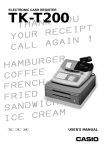
![RessqM, Enhanced Version of RESSQ [Javandel et al., 1984]](http://vs1.manualzilla.com/store/data/005674408_1-e8a4b9f66c80cdc83d847a710e5b4b1f-150x150.png)
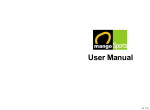
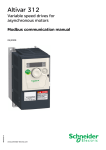

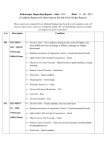

![[1.7 APPLICATION FUNCT.] (FUn](http://vs1.manualzilla.com/store/data/005795769_1-62115863bd572564b923fbca39341baa-150x150.png)
